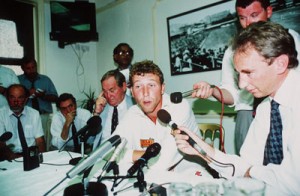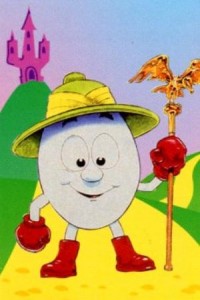
A gradual but inevitable descent into cricket-based loathing and bile.
Whatever Happened To The Unlikely Lads? #24: John Crawley
One of the reasons that life as a 51allout writer is so desperately, desperately lonely is our constant obsession with looking back at the 1990s. Like those weird religious cults that refuse to accept the advances of technology beyond a certain point, ours is a life of TFI Friday repeats, forever anticipating new material from Kula Shaker and worshipping at the altar of Julia Sawalha. It makes it quite a challenge to form normal relationships, seeing as most people freak out as soon as we start showing them our CD collection.
But why are we so obsessed with one particular decade? A couple of reasons: firstly, we really do love the music of Kula Shaker; secondly, because the mental scars of a decade of hilariously inept England performances will never heal. Year after year of winning the toss, batting and being bowled out for 150 can never be forgotten. Rather than move on with our lives, we’ve simply become addicted to the pain. Luckily for us, this gives us plenty of chances to talk about any number of English cricketers who completely and utterly failed to stop the rot, instead becoming yet another cog in the well oiled machine’s inexorable slide towards disaster. Cricketers such as
#24: John Paul Crawley
Perhaps the most famous English failures of the 1990s are two batsmen who seemed to have all the attributes required to conquer international cricket, but both of whom failed spectacularly: Graeme Hick and Mark Ramprakash. Alongside these two prodigious talents was a slightly younger third who also failed to hit the heights but, luckily for him, is mocked far less often in ironic looks back at England’s glory days. John Crawley’s failure may have been less dramatic than those other two but was no less damning an indictment of an environment perfectly set up for failure.
As a youngster Crawley was a runscoring prodigy, breaking Mike Atherton’s batting records at Manchester Grammar School before moving on to play for Cambridge University and then Lancashire, while also completing his degree in having a really shiny head. His first class debut came in 1990 and four years later he was part of the England team to take on South Africa at Lord’s.
As debuts go, it was more Jonathan Woodgate than Jonathan Trott. Batting at number three, Crawley made scores of 9 and 7 and England lost by the small matter of 356 runs. Luckily, all talk of incredibly rubbish debuts was overshadowed by Mike Atherton and the ‘dirt in the pocket’ scandal. To be fair to Atherton, if we were stuck with a bowling attack that included Ian Salisbury we’d consider trying controversial alternative methods of getting wickets too.

Atherton admits picking Ian Salisbury when heavily under the influence of gin. Aggers is not impressed.
In a sign of the times, Crawley shifted down the order to number six for his second match, in which he made 38 and a duck in a draw. He then followed that up with 5 in his only innings at The Oval, as England won by 8 wickets to square the series. So far, so rubbish, with 59 runs at a mighty average of 11.80.
Perhaps unsurprisingly, England weren’t exactly blown away by the contribution of a man that some considered overweight. It was therefore with no small grasp of irony that they chose to replace him for the following Ashes series with Mike Gatting. Even more unsurprisingly, England got battered in the first two matches of the series. Alec Stewart was then injured and Crawley returned for the third Test in Sydney, making 72 in the first innings as England had the better of a rain-affected draw.
The fourth Test saw Crawley (shifted up to number five) make another 78 in the second innings as England completed a remarkable victory. Belatedly, Crawley had arrived on the international scene. As if to entirely undermine that point he made a pair in the final game at the WACA, England crumbling to another heavy defeat.

After dismissing Crawley in the first innings, Mark Waugh found it hard to come to terms with his new celebrity status.
From there the Crawley story follows a traditional pattern. He was left out of the first three Tests at home to the West Indies in the following summer before playing the last three, played just a single (rain ruined) Test in South Africa and missed the first Test against Pakistan in the summer of 1996 before returning for the second with 53. That was followed by a maiden hundred in the third Test of the series, a game England still managed to emphatically lose by nine wickets.
Two more Test hundreds followed for Crawley as he drifted in and out of the side all the way through to the Ashes of 1999. At that point patience finally seemed to run out. It’s hard to argue with that decision; 29 matches for an average of 31.64 might be decent enough for an allrounder – it’s just below Rikki Clarke’s 32.00 – but nowhere near the required standard for someone marked for stardom from a young age.
Of course, England being England, they left it for a couple of years before bringing Crawley back yet again. In 2002 he reappeared to take on Sri Lanka and India, making a fourth Test hundred against the latter, before being part of that year’s Ashes squad. England were yet again thrashed, Crawley yet again flattered to deceive and he was once more cut adrift, this time permanently.
Crawley was a very un-English batsman in many ways. He was comfortable against spin for a start, which means he could well have been recalled this year, had he not foolishly retired in 2009. Unfortunately at international level he regularly displayed the very English trait of lacking the fight to succeed. Despite having made more than 24,000 runs at First Class level his Test career will forever remain a disappointment. Plus his head really does look like an egg.

Quite how Crawley came to be pictured with the number one Test team’s mace was never satisfactorily explained.

2 Comments
Post a Comment
1
Nichael Bluth
13 Jan 2013 04:03
A lot more.
2
Matt H
12 Jan 2013 10:37
One of my favourite cricket facts is that for one season in the 1990s, Lancashire had five current first-class captains playing for them: John Crawley (Cambridge Uni), Jason Gallian (Oxford Uni), Wasim Akram (Pakistan), Michael Atherton (England) and Mike Watkinson (Lancashire). I know I should get out more.